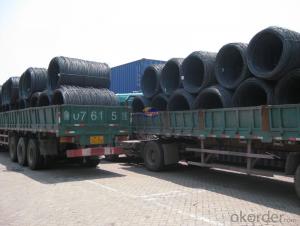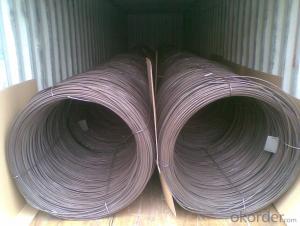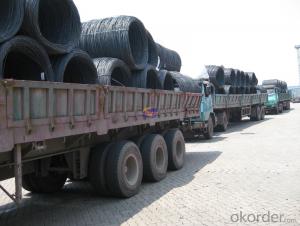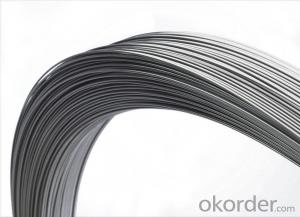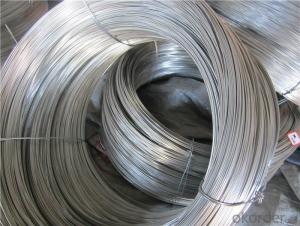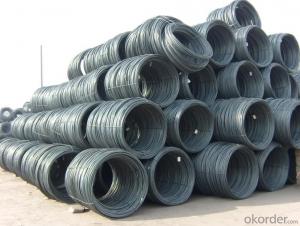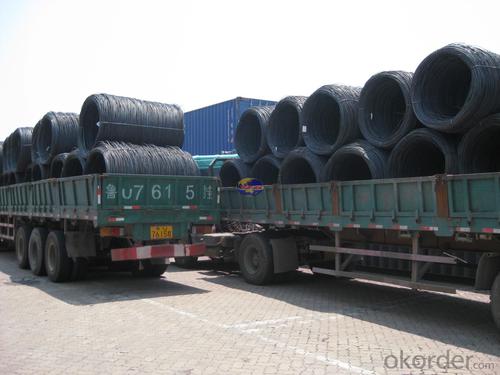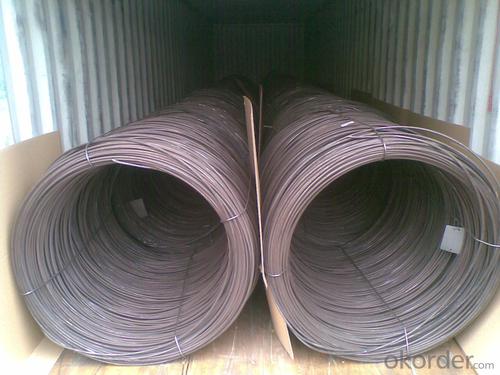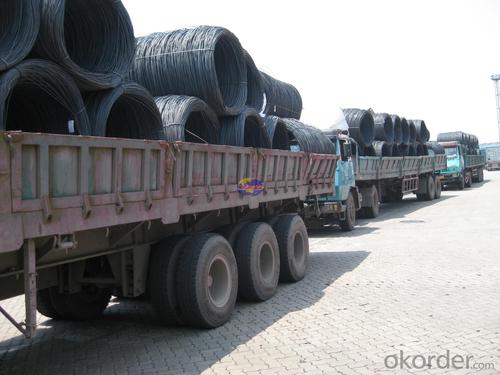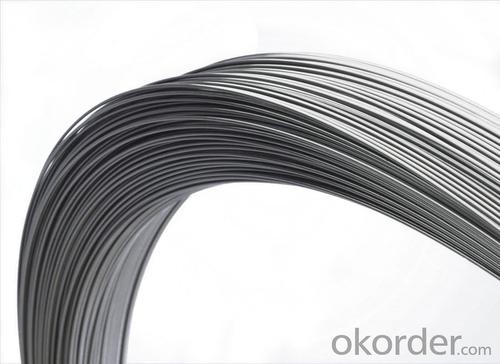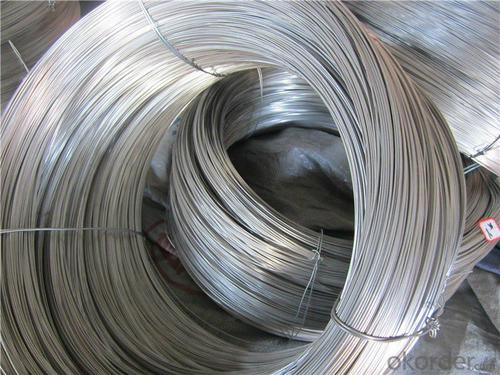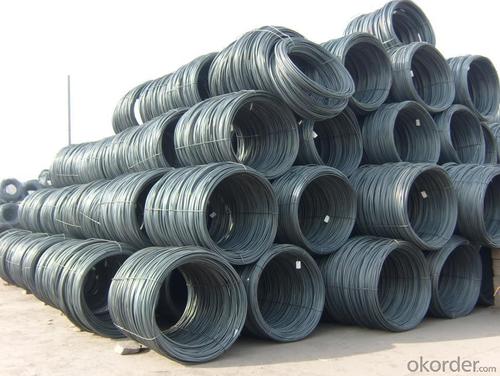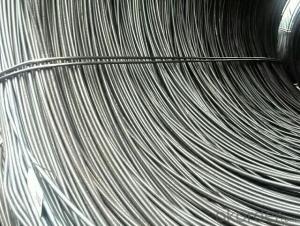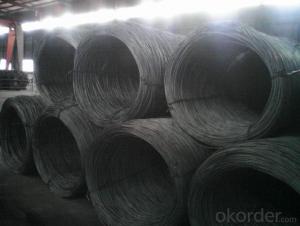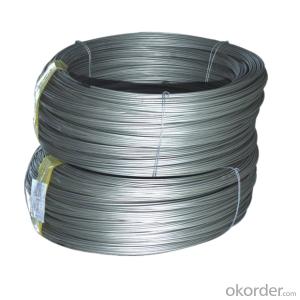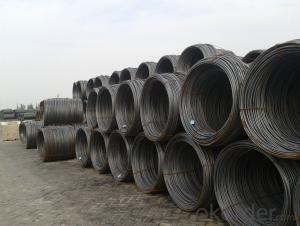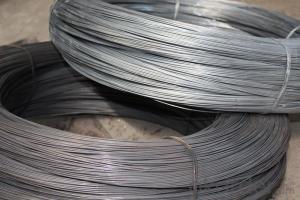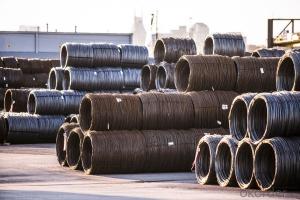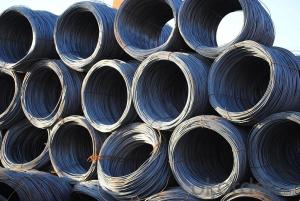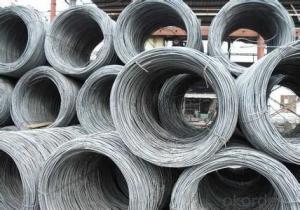SAE1006Cr Carbon Steel Wire Rod 15.5mm for Welding
- Loading Port:
- Shanghai
- Payment Terms:
- TT OR LC
- Min Order Qty:
- 100 m.t
- Supply Capability:
- 30000 m.t/month
OKorder Service Pledge
OKorder Financial Service
You Might Also Like
Specification
Description of SAE1006Cr Carbon Steel Wire Rod 15.5mm for Welding:
OKorder is offering Color Coated Steel Coil Prepainted Steel Coil at great prices with worldwide shipping. Our supplier is a world-class manufacturer of steel, with our products utilized the world over. OKorder annually supplies products to European, North American and Asian markets. We provide quotations within 24 hours of receiving an inquiry and guarantee competitive prices.
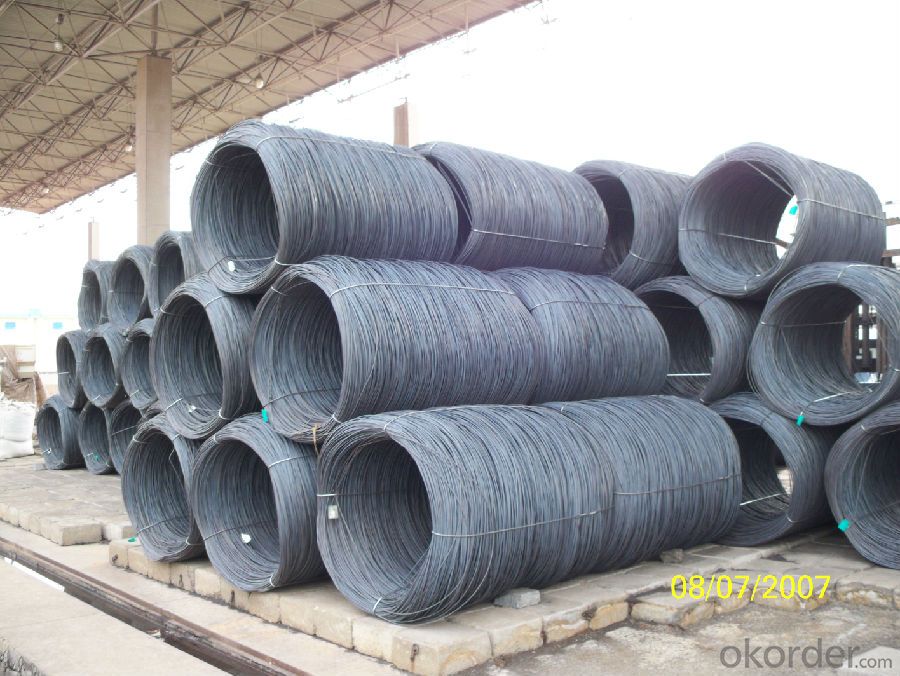
Applications of SAE1006Cr Carbon Steel Wire Rod 15.5mm for Welding:
Color Coated Steel Coil Prepainted Steel Coil are ideal for structural applications and are widely used in the construction of buildings and bridges, and the manufacturing, petrochemical, and transportation industries.
Main Product Features of SAE1006Cr Carbon Steel Wire Rod 15.5mm for Welding:
· Premium quality
· Prompt delivery & seaworthy packing (30 days after receiving deposit)
· Corrosion resistance
· Can be recycled and reused
· Mill test certification
· Professional Service
· Competitive pricing
Specifications of SAE1006Cr Carbon Steel Wire Rod 15.5mm for Welding:
1, Introduction: Color coated steel coils(sheets), i. E. PPGI, also called prepainted steel coils(sheets), are made of galvanized steel coils(sheets) with polymer coatings as surface. It's a new enclosure material and building board with characteristics of light-weighted, heat preserved&insulated, easily installed with bright colors.
2, Production Process: Pretreatment(Degreasing)_Drying_Chromating_Paint Basic Oil_Cooling_Drying_Color Coating_Cooling_Film-covering_Rolling Up
3, Characteristics:
Good at corrosion resistence. Besides zinc coating of the basic plate of galvanized steel sheet, the color coating as the surface has double lifetime to ensure better anticorrosion effect.
With excellent cold bending molded manufacturablity, PPGI products can be processed or directly used as final product. As being light-weighted and conveniently transported, they're widly used to replace wood to save energy.
4.There're thousands of colors can be chosen as per different application. Any color plays well in decoration.
No pollution with high recycling rate, PPGI coils and sheets are strongly recommended as enviroment-friendly products by the government.
5, eye bands and 4 circumferential bands in steel, galvanized metal fluted rings on inner and outer edges, galvanized.
| commodity | SAE1006Cr Carbon Steel Wire Rod 15.5mm for Welding |
| Techinical Standard: | JIS G3302-1998, EN10142/10137, ASTM A755 |
| grade | Q195,Q215,Q235,SAE1006,SAE1008 SAE1006Cr |
| Types: | Mesh welding |
| Base metal | galvanized, galvalume, cold rolled steel |
| Thickness | 0.14-1.0mm(0.16-0.8mm is the most advantage thickness) |
| Width | 610/724/820/914/1000/1200/1219/1220/1250mm |
| Type of coating: | PE, SMP, PVDF |
| Zinc coating | Z60-150g/m2 or AZ40-100g/m2 |
| Top painting: | 5 mic. Primer + 15 mc. R. M. P. |
| Back painting: | 5-7 mic. EP |
| Color: | According to RAL standard |
| ID coil | 508mm610mm |
| Coil weight: | 2--3MT |
| Package: | Properly packed for ocean freight exportation in 20'containers |
| Application: | Industrial panels, roofing and siding for painting/automobile |
| Price terms | FOB, CFR, CIF |
| Payment terms | 20%TT in advance+80% TT or irrevocable 80%L/C at sight |
| delivery time | 25 days after recepit of 20% TT |
| Remarks | Insurance is all risks |
| MTC 3.1 will be handed on with shipping documents | |
| We accept SGS certificatation test |
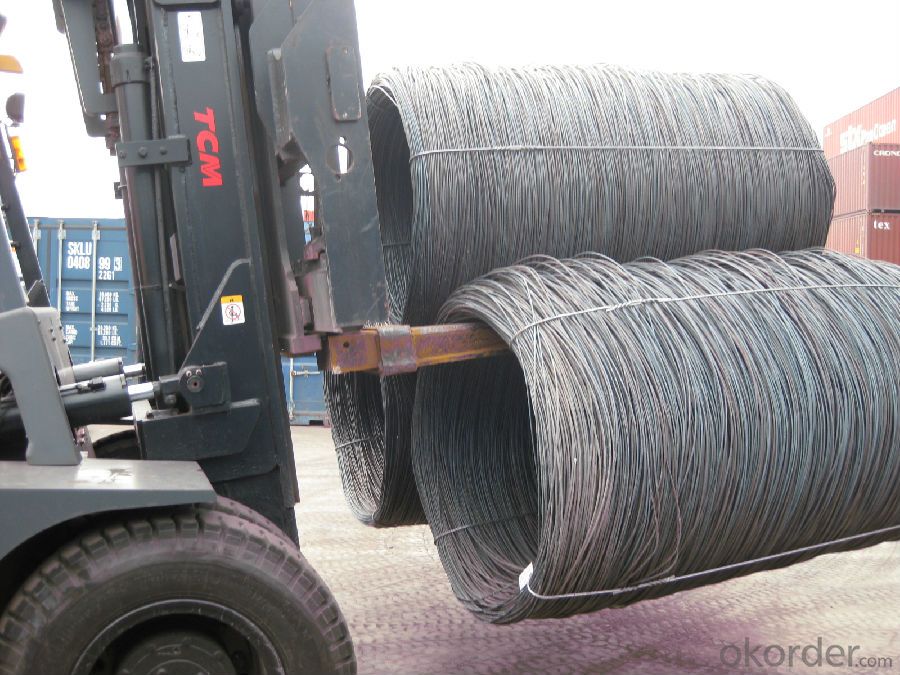
FAQ of SAE1006Cr Carbon Steel Wire Rod 15.5mm for Welding:
Q1: Why buy Materials & Equipment from OKorder.com?
A1: All products offered byOKorder.com are carefully selected from China's most reliable manufacturing enterprises. Through its ISO certifications, OKorder.com adheres to the highest standards and a commitment to supply chain safety and customer satisfaction.
Q2: How do we guarantee the quality of our products?
A2: We have established an advanced quality management system which conducts strict quality tests at every step, from raw materials to the final product. At the same time, we provide extensive follow-up service assurances as required.
Q3: How soon can we receive the product after purchase?
A3: Within three days of placing an order, we will begin production. The specific shipping date is dependent upon international and government factors, but is typically 7 to 10 workdays.
Q4: What makes stainless steel stainless?
A4: Stainless steel must contain at least 10.5 % chromium. It is this element that reacts with the oxygen in the air to form a complex chrome-oxide surface layer that is invisible but strong enough to prevent further oxygen from "staining" (rusting) the surface. Higher levels of chromium and the addition of other alloying elements such as nickel and molybdenum enhance this surface layer and improve the corrosion resistance of the stainless material.
Q5: Can stainless steel rust?
A5: Stainless does not "rust" as you think of regular steel rusting with a red oxide on the surface that flakes off. If you see red rust it is probably due to some iron particles that have contaminated the surface of the stainless steel and it is these iron particles that are rusting. Look at the source of the rusting and see if you can remove it from the surface.
- Q: How is steel wire rod used in the production of wire for automotive seat springs?
- Steel wire rod is used in the production of wire for automotive seat springs by being processed through various mechanical and heat treatments to enhance its strength and flexibility. This wire rod is then drawn into thinner wire strands that are coiled and formed into the spring shapes required for automotive seat applications. The high tensile strength of steel wire rod ensures that the seat springs can withstand the weight and pressure exerted on them, providing durability and comfort to the users.
- Q: How is steel wire rod tested for elongation?
- Steel wire rod is tested for elongation using a tensile test, where a sample of the rod is pulled until it breaks. The change in length of the sample is measured and expressed as a percentage of its original length to determine its elongation.
- Q: How is the brittleness of steel wire rod determined?
- The brittleness of steel wire rod is typically determined by conducting a series of mechanical tests, such as the Charpy impact test or the tensile test. These tests help measure the amount of force or energy required to fracture or break the steel wire rod, providing an indication of its brittleness. Additionally, microscopic examination techniques, like optical microscopy or scanning electron microscopy, can be used to analyze the internal structure of the steel wire rod and identify any signs of brittleness, such as the presence of cracks or grain boundaries.
- Q: What are the common applications of galvanized and oil tempered steel wire rod?
- Due to its protective zinc coating, galvanized steel wire rod finds wide application in various fields. The galvanization process involves applying a layer of zinc to the surface of the steel wire rod, which offers excellent resistance against corrosion. This makes galvanized steel wire rod the ideal choice for situations where the material will be exposed to moisture, chemicals, or harsh environments. Some common uses of galvanized steel wire rod include: 1. Fencing and wire mesh: Galvanized steel wire rod is extensively utilized in the construction of fences and wire mesh. The zinc coating helps to prevent rust and corrosion, ensuring the long-lasting and durable nature of the fencing or mesh. 2. Construction: Galvanized steel wire rod is employed in numerous construction applications, such as reinforcing concrete. The added strength and corrosion resistance of galvanized steel make it an excellent option for reinforcing structures and providing stability. 3. Automotive industry: Galvanized steel wire rod is used in the manufacture of automotive parts and components. It is often employed in the production of springs, suspension systems, and wire harnesses due to its high strength and resistance to corrosion. 4. Electrical applications: Galvanized steel wire rod is commonly used in electrical applications, including cable armor and grounding wires. The zinc coating provides an extra layer of protection against corrosion, ensuring the safety and reliability of electrical systems. On the other hand, oil tempered steel wire rod is a high-strength material that undergoes heat and oil treatment to improve its mechanical properties. This process involves heating the steel wire rod to a specific temperature and then quenching it in oil. The result is a wire rod with enhanced toughness, durability, and resistance to fatigue. Some common uses of oil tempered steel wire rod include: 1. Springs: Oil tempered steel wire rod is widely employed in the production of springs, such as coil springs, suspension springs, and valve springs. The high strength and excellent fatigue resistance of oil tempered steel make it ideal for applications that require reliable and long-lasting springs. 2. Mechanical components: Oil tempered steel wire rod is used in the manufacture of various mechanical components, including shafts, gears, and fasteners. Its high strength and toughness make it suitable for applications where durability and reliability are crucial. 3. Automotive industry: Oil tempered steel wire rod is extensively utilized in the automotive industry for applications such as seat frames, seat belts, and suspension systems. The superior mechanical properties of oil tempered steel ensure the safety and performance of automotive components. 4. Industrial equipment: Oil tempered steel wire rod is employed in a wide range of industrial equipment, such as conveyor belts, wire ropes, and crane cables. Its high tensile strength and resistance to fatigue make it an ideal material for handling heavy loads and enduring demanding conditions. In conclusion, both galvanized and oil tempered steel wire rods have their unique applications and advantages. Galvanized steel is primarily selected for its corrosion resistance, while oil tempered steel is chosen for its high strength and durability.
- Q: What are the environmental considerations associated with steel wire rod production?
- Steel wire rod production has several environmental considerations. One of the primary concerns is the energy consumption and greenhouse gas emissions associated with the manufacturing process. Steel wire rod production requires high temperatures, which are typically achieved through the combustion of fossil fuels such as coal or natural gas. This combustion releases carbon dioxide, contributing to global climate change. Additionally, the extraction of raw materials for steel wire rod production, such as iron ore and coal, can have detrimental effects on the environment. Mining activities can lead to deforestation, habitat destruction, and soil erosion. Furthermore, the transportation of these raw materials to the production facilities can also result in additional carbon emissions. Water usage is another significant environmental consideration. Steel wire rod production requires large amounts of water for cooling purposes and the removal of impurities. This can strain local water resources, particularly in areas with limited water availability or during periods of drought. Waste management is also critical in steel wire rod production. The process generates various by-products and waste materials, including slag and dust. Proper disposal or treatment of these waste materials is essential to prevent pollution of soil, water, and air. Furthermore, steel wire rod production can have indirect environmental impacts through the use of chemicals and additives. These substances may be used for various purposes, such as corrosion prevention or enhancing the mechanical properties of the wire rod. The improper handling or disposal of these chemicals can lead to environmental contamination. To mitigate these environmental considerations, steel wire rod producers should invest in cleaner and more energy-efficient technologies, such as using renewable energy sources or implementing energy-efficient furnaces. Additionally, recycling scrap steel instead of solely relying on virgin raw materials can significantly reduce the environmental impact of steel wire rod production. Implementing water conservation measures and developing comprehensive waste management plans are also crucial to minimize the environmental footprint of this manufacturing process.
- Q: What are the common production processes for radium-coated steel wire rod?
- The common production processes for radium-coated steel wire rod typically involve several steps. First, the steel wire rod is cleaned and prepared for coating. It is then dipped or sprayed with a radium-based solution to apply a thin layer of radium coating. The coated wire rod is then dried or cured to ensure the adhesion and stability of the radium coating. Finally, the wire rod may undergo additional processes such as cutting, shaping, or packaging, depending on its intended use.
- Q: What are the main factors influencing the choice of steel wire rod transportation method?
- The main factors influencing the choice of steel wire rod transportation method include the distance to be traveled, the quantity of steel wire rods to be transported, the urgency of delivery, the type and size of the wire rods, the availability of transportation options, cost considerations, and the sensitivity of the wire rods to damage or corrosion during transit. Additionally, factors such as infrastructure, logistical requirements, and regulatory constraints may also play a role in determining the most suitable transportation method.
- Q: How is the quality of steel wire rod assessed?
- The quality of steel wire rod is assessed based on various factors, including its chemical composition, physical properties, and surface condition. This assessment is done through rigorous testing and inspection methods such as spectroscopy, tensile strength testing, and visual examination. These evaluations ensure that the steel wire rod meets the required industry standards and specifications, guaranteeing its strength, durability, and suitability for various applications.
- Q: How is steel wire rod used in the production of springs for mattresses?
- Steel wire rod is used in the production of springs for mattresses as it serves as the raw material for creating the spring coils. The wire rod is first processed and shaped into a coiled form, which is then further processed to create the desired spring shape and size. This allows for the creation of strong and durable springs that provide support and resilience to mattresses, ensuring a comfortable sleeping surface.
- Q: What are the different sizes and dimensions of steel wire rod?
- Steel wire rods are available in a variety of sizes and dimensions to accommodate different industrial and commercial uses. The intended use and manufacturing standards typically determine the sizes and dimensions of steel wire rods. The diameter of steel wire rods can vary from as small as 0.1 millimeters (mm) to as large as 60 mm or more. Generally, the most common sizes in the market range between 5 mm and 20 mm in diameter. However, specialized applications may necessitate wire rods with larger or smaller diameters. The length of steel wire rods can vary significantly depending on the requirements. They are often produced in coils, which can range in length from a few meters to several kilometers. The length of wire rods can be customized to meet the customer's needs or industry standards. Regarding dimensions, steel wire rods are typically manufactured in a round shape. However, they can also be produced in other shapes such as square, rectangular, or hexagonal, depending on the specific application. The most prevalent shape is round because it provides excellent strength and flexibility for various uses. Furthermore, the weight of steel wire rods can vary based on the diameter and length. Usually, the weight is measured in kilograms (kg) or pounds (lb). The weight per unit length is determined by the specific gravity of the steel and the diameter of the wire rod. In conclusion, the sizes and dimensions of steel wire rods are extensive and can be customized to meet specific requirements. Whether it is for construction, automotive, or other industries, steel wire rods are available in a wide range of sizes to accommodate various applications.
Send your message to us
SAE1006Cr Carbon Steel Wire Rod 15.5mm for Welding
- Loading Port:
- Shanghai
- Payment Terms:
- TT OR LC
- Min Order Qty:
- 100 m.t
- Supply Capability:
- 30000 m.t/month
OKorder Service Pledge
OKorder Financial Service
Similar products
Hot products
Hot Searches
Related keywords
